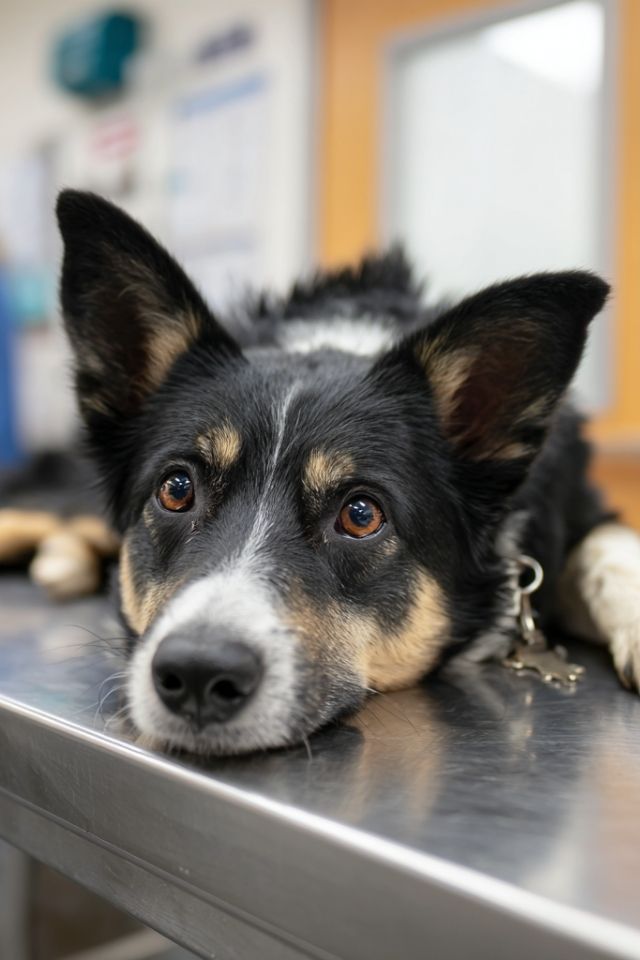There’s a moment every guardian of a pancreatitis-prone dog remembers with crystal clarity—the moment you realized something was terribly wrong. Perhaps it was the way your Miniature Schnauzer curved his body into that telltale arch, or how your Cocker Spaniel’s eyes went flat with pain. In that moment, the world narrowed to a single, desperate question: How do I protect you?
What follows isn’t just about food. It’s about the invisible language between species, the way trust is built through consistent care, and how understanding becomes the foundation of healing. This is the story of dogs whose bodies carry a metabolic vulnerability written into their genetic code—and the humans who learn to read the subtle whispers before they become screams.
The Metabolic Story Written in Genes
Picture the pancreas as a quiet alchemist, tucked behind the stomach, transforming what we feed into what sustains life. In most dogs, this organ works with elegant efficiency. But in certain breeds—Miniature Schnauzers, Cocker Spaniels, Yorkshire Terriers—something in the genetic blueprint shifts the balance.
These dogs carry what scientists call idiopathic hyperlipidaemia, a twenty-syllable term that means their blood doesn’t clear fats the way it should. The enzyme responsible—lipoprotein lipase—moves slower, works less efficiently. Imagine trying to clear traffic from a highway when half the exits are closed. That’s what happens inside their bloodstream after every meal. Fats linger. Triglycerides accumulate. The pancreas, sensing this metabolic traffic jam, begins to overproduce digestive enzymes in a misguided attempt to help.
But here’s where the story takes its dangerous turn. Those enzymes, meant to break down food in the intestines, activate too early. They turn on the pancreas itself. What should be a controlled, external process becomes internal destruction—the body digesting its own tissues.
Through the lens of NeuroBond, we begin to see this not as mechanical failure but as a conversation gone wrong between systems. The gut speaks to the pancreas, the pancreas responds, hormones carry messages through the bloodstream. When one part of the conversation becomes garbled—through genetics, through diet, through stress—the entire system suffers.
And long before you see the acute crisis, inflammation has been whispering. Studies reveal that subclinical inflammation simmers for weeks, sometimes months, beneath the surface. Oxidative stress accumulates like sediment in a river. The body remembers these insults, becoming more sensitive, more reactive, until one high-fat meal becomes the match that ignites the kindling.
The Weight of Invisible Burdens
Sarah didn’t realize her Schnauzer, Max, was carrying extra weight until the veterinarian placed him on the scale. “He’s only a few pounds over,” she thought. But in a twenty-pound dog, three extra pounds shifts the entire metabolic landscape.
Obesity isn’t simply about appearance. In dogs prone to pancreatitis, excess adipose tissue becomes an endocrine organ gone rogue—secreting leptin that overstimulates the pancreas, releasing inflammatory molecules that sensitize tissues, altering the very hormone signals that govern hunger and satiety. The research is clear: overweight dogs show significantly elevated serum lipids compared to their lean counterparts. That elevation isn’t cosmetic. It’s metabolic stress made measurable.
And obesity rarely travels alone. It brings insulin resistance as a companion—cells that no longer respond properly to insulin’s knock at the door. The pancreas compensates by producing more and more insulin, creating hyperinsulinemia that drives further weight gain in a vicious cycle. For breeds already predisposed to pancreatic sensitivity, this becomes the perfect storm.
Add endocrine disorders into the equation—Cushing’s syndrome with its excess cortisol flooding the system, or hypothyroidism slowing metabolism to a crawl—and the pancreas finds itself in an environment it was never designed to navigate.
But here’s the grace in this story: early intervention changes everything. When you catch the trajectory before permanent damage sets in, when you implement protective protocols while the tissue is still healthy and responsive, you’re not just managing disease. You’re rewriting the ending.
Nourishment as Medicine: Building the Foundation
The question isn’t whether to change your dog’s diet. The question is how to transform meals from metabolic threats into acts of healing.
Fat becomes the central character in this nutritional story, but not the villain some portray it as. Your dog needs essential fatty acids—they’re not optional for health. The art lies in selection and precision. Lean proteins become your foundation: chicken breast with skin removed, turkey, white fish that flakes easily under a fork. These deliver amino acids without the pancreatic burden of marbled meats.
But within the world of fats, omega-3 fatty acids—specifically EPA and DHA—emerge as unlikely heroes. These long-chain molecules don’t just reduce inflammation; they actively resolve it. They transform into resolvins and protectins, specialized molecules that tell the inflammatory process when to stop. They shift the balance away from destructive inflammation toward healing.
Picture inflammation as a fire alarm that won’t turn off. Omega-3s are the hand that finally reaches the button and restores silence. This isn’t metaphor—it’s measurable biochemistry. Studies show that EPA and DHA down-regulate inflammatory eicosanoids, target the NLRP3 inflammasome (a key player in chronic inflammation), and shift immune responses toward resolution rather than perpetual reactivity.
You’ll supplement daily with fish oil or microalgae-based omega-3s, yes. But more than that, you’re giving your dog’s cells the molecular tools they need to communicate healing. This is NeuroBond at the cellular level—creating the conditions for the body to remember what balance feels like.
A word of caution about medium-chain triglycerides, often promoted as pancreas-friendly: recent research shows they may actually decrease levels of beneficial omega-3s in the bloodstream. Sometimes what seems helpful creates subtle harm. Trust the evidence over the marketing.
The Rhythm of Small Meal
There’s a rhythm to traditional dog feeding—morning bowl, evening bowl, the day punctuated by hunger and satiety. But for the pancreatitis-prone dog, this rhythm creates metabolic crescendos that stress the system.
Imagine asking your dog’s pancreas to handle a flood of nutrients twice daily versus a steady stream throughout the day. Research across multiple species shows that large, infrequent meals create hormonal surges—spikes in insulin, dramatic rises in blood lipids, stress responses that echo through metabolic pathways.
When you shift to three or four smaller meals, you’re not just dividing food differently. You’re creating metabolic stability. The pancreas encounters manageable work at regular intervals rather than overwhelming demands twice daily. Blood sugar stays steadier. Lipid levels avoid the dramatic postprandial spikes that trigger enzyme activation.
This is the Invisible Leash—guidance through structure rather than restriction. You’re not depriving your dog; you’re creating the framework within which their body can function optimally. The pancreas, freed from feast-or-famine stress, begins to remember its natural rhythm.
The Four-Week Passage: A Story of Transitio
Every journey begins with a single step, but this one requires four weeks of mindful progression. Rushing creates the very digestive upset you’re trying to prevent. The pancreas, liver, intestines, and the trillions of bacteria in the gut—all need time to adjust to new macronutrient ratios, new ingredients, new patterns.
Week one feels like an introduction. You’re mixing 75% of the old diet with 25% of the new, typically at breakfast while you’re home to observe. Your dog might approach the bowl with curiosity or suspicion. You’re watching stools—the body’s most honest feedback about digestion. Omega-3 supplementation begins at just a quarter of the target dose, a gentle hello to fish oil’s effects.
Week two brings you to equal parts old and new. By now, you’ve seen how your dog responds. Perhaps their energy shifted slightly, or their coat already shows a subtle shine from the omega-3s (now at half-dose). You’re preparing mentally for the bigger shift ahead, measuring out smaller portions, visualizing the new rhythm.
Week three is where commitment meets reality. You’re at 75% new food, and you’re implementing the three-meal schedule that will become your daily practice. This is the week that tests your resolve. Your dog might act confused about the midday meal, might seem hungry with smaller portions. Hold steady. The Invisible Leash is your calm certainty that this structure serves their deepest wellbeing.
Week four arrives like a destination reached—100% new diet, full omega-3 supplementation, an established rhythm to your days. But the journey isn’t over. Now you fine-tune based on what your dog’s body tells you: their energy, their weight, their enthusiasm at mealtimes.
If digestive upset appears—and it might—you slow the transition without judgment. There’s no prize for speed. The only goal is successful, comfortable adaptation. Some dogs transition easily in two weeks; others need eight. Trust your dog’s timeline, not an arbitrary calendar.
The Language of Treats: Connection Without Compromise
Here’s a truth that breaks hearts initially: those commercial dog biscuits, that cheese you’ve been using for training, the bacon-flavored treats—they have to go. For about five minutes, this feels like loss. Then you discover the vast landscape of what you can offer, and loss transforms into creative abundance.
A baby carrot becomes a reward. Four calories of crunchy sweetness. A single blueberry—one calorie, bursting with antioxidants. Cucumber slices for the dogs who love that cool, refreshing crunch. Green beans that snap satisfyingly between teeth. These aren’t deprivation; they’re discovery.
You learn to make sweet potato jerky in your oven—sliced thin, baked low and slow until chewy. You freeze low-sodium chicken broth with a bit of parsley into ice cube trays. On hot days, these become treasures. You roll pumpkin puree with oat flour and egg white into tiny drops, each one a training reward that costs two calories and nearly zero fat.
But here’s the deeper truth: your dog doesn’t know these are “diet treats.” They know your voice lifts with enthusiasm. They know you’re paying attention to them. The treat is the excuse for connection; the connection is the real reward.
Through Soul Recall, we recognize that your dog remembers not the specific treat but the emotional tone of the moment you offered it. The warmth in your eyes. The pride in your voice. The way you knelt to their level. That’s what creates the neural pathway, the positive association that strengthens behavior.
So yes, you’ll calculate that treats should represent only 5-10% of daily calories. Yes, you’ll measure and track. But you’ll also discover that breaking one approved treat into six tiny pieces gives your dog six moments of connection while consuming the calories of one. That’s not compromise—that’s wisdom.
The Hidden Architecture of Wellness
There’s a story beneath the story, forces that shape pancreatic health beyond what enters the food bowl. Stress, for instance—invisible but powerfully metabolic.
When your dog experiences stress, their body releases cortisol. This ancient hormone, designed for short-term survival responses, alters how the liver processes glucose, how adipose tissue releases fats, how the pancreas responds to hormonal signals. Chronic stress becomes chronic inflammation. The pancreas, already vulnerable, becomes hypersensitive.
You might not notice that the construction noise outside has been raising your dog’s baseline cortisol for weeks. That boarding over the holidays, those weekend guests, the new puppy next door—each adds to an invisible burden the body carries. Until it doesn’t carry it anymore.
Creating sanctuary becomes part of your protocol. Predictable routines that let your dog’s nervous system settle. A quiet space where they can retreat. Perhaps Adaptil diffusers releasing calming pheromones, or gentle music designed to soothe canine stress responses. You learn to read the subtle signs—the tucked tail, the hypervigilance, the pacing—before they escalate.
Medications, too, write their own stories. Some necessary drugs—corticosteroids for severe allergies, anti-seizure medications, certain antibiotics—carry increased pancreatitis risk. You don’t stop life-saving treatment, but you implement the strictest dietary protocols when these medications are necessary. You monitor more closely. You understand that every choice carries both benefit and cost, and you navigate with eyes open.
Even toxins play their role—the xylitol in sugar-free products, grapes left accessible on a counter, household cleaners with harsh degreasers, the sago palm someone gifted not knowing its deadly potential. You become vigilant not from paranoia but from love.
And exercise timing matters more than most realize. That enthusiastic fetch game right after dinner? It redirects blood flow from digestive organs to muscles at precisely the wrong moment. You learn to walk before meals, to wait an hour or two after eating before vigorous play. These small adjustments compound into significant protection.
The gut microbiome—those trillions of bacteria—influences systemic inflammation through pathways we’re only beginning to map. Supporting them with quality probiotics and prebiotic fiber from pumpkin or sweet potato becomes another layer of care. A healthy gut supports a healthy pancreas; they speak to each other constantly through the gut-pancreas axis.
This is what we mean when we talk about holistic care. Not alternative medicine but comprehensive understanding—recognizing that your dog’s body is an ecosystem, not a machine, and every element affects every other.
The Practice: Sunday Afternoon Medicine
For many guardians, Sunday afternoon becomes sacred time. Not for spiritual reasons, but for practical ones—this is when you batch-cook the week’s meals.
The kitchen fills with the scent of simmering chicken breast, sweet potatoes roasting, vegetables steaming. You’ve laid out your tools: the digital scale that measures in grams, the portion containers that will hold each meal, the labels you’ll date and mark. This is ritual, yes, but also relationship. Every measured portion is an act of advocacy for a creature who cannot advocate for themselves.
You cook lean proteins using three methods simultaneously—slow cooker for chicken, oven for turkey, stovetop for white fish. While they cool, you portion cooked sweet potato, measure out steamed green beans, divide the oats you’ll rotate in. Two to three hours of focused work creates twenty-one meals—a full week of protection.
Some meals go into the refrigerator for the next few days. The rest enter the freezer, labeled clearly: “Monday breakfast,” “Thursday dinner,” each one dated. You’ll move frozen meals to the fridge the night before, allowing safe overnight thawing.
This might sound tedious described this way. But there’s a meditative quality to the work once you find your rhythm. The repetitive motions free your mind. You think about your dog’s progress, the way their eyes brightened this week, how their coat has improved. You remember the crisis that brought you here and feel gratitude that you have the knowledge and resources to protect them going forward.
For those who can’t batch-cook—perhaps your schedule is too unpredictable, your kitchen too small—there are alternatives. High-quality prescription pancreatic-support diets for one or two meals daily, with just one meal home-cooked. Or the fifteen-minute daily method: keep pre-cooked proteins in the fridge, quickly assemble each meal fresh. Different paths to the same destination.
When Multiple Dogs Share Your Home
The complexity multiplies when you’re guardian to several dogs, each with different needs. Your pancreatitis-prone Schnauzer requires strict fat restriction. Your young Labrador needs calorie-dense food for growth and energy. Your senior mixed breed has kidney concerns requiring yet another protocol.
This is where the Invisible Leash extends to household management. You establish feeding stations—different rooms, different times, or simultaneous crate feeding where each dog has their protected space. Baby gates create visual barriers. You teach “place” so reliably that each dog remains on their designated spot during meal preparation and feeding.
Some families choose to feed everyone the same pancreas-safe diet if all dogs are adults with no conflicting needs. This simplifies logistics, reduces the temptation for food stealing, and sometimes proves more economical. Other families maintain separate protocols because their athletic working dog simply cannot maintain condition on a very low-fat diet, or their growing puppy needs different nutrition.
There’s no single right answer, only the answer that works for your specific pack. The key is structure, consistency, and clear boundaries. Dogs adapt beautifully to routine when humans provide steady leadership. They’re not confused by different rules for different pack members—they’re confused by inconsistent enforcement of those rules.
Training becomes essential: bulletproof “leave it” commands, impulse control exercises, reward systems that respect individual needs. Your special-diet dog gets low-fat treats; siblings get their appropriate rewards. Everyone receives attention and connection, just customized to their requirements.
This is NeuroBond expanded beyond the individual to encompass the pack. You’re creating harmony through understanding each dog’s unique needs while maintaining the structure that lets all thrive.
Reading the Signs: When the Body Speaks
You become fluent in a new language—the language of your dog’s body in relationship to food and wellbeing. You learn to read subtle shifts in energy that precede problems. The slight lethargy after meals that suggests postprandial discomfort. The way they arch their back just barely, or how their abdomen feels tighter when you gently palpate.
Stools become a daily text you interpret—firm and well-formed means all is well; persistent softness suggests too much fat or too-rapid transition; sudden changes warrant immediate attention. Weight is measured weekly, not guessed by eye. Body condition score is assessed monthly, hands running along ribs, feeling the contour of the waist from above.
But you’re also watching for signs of success. The consistent enthusiasm at mealtimes, the steady energy throughout the day, the bright eyes and glossy coat that reflect good nutrition. The absence of vomiting, diarrhea, or pain behaviors. The way your dog moves through life with ease rather than the guarded carefulness that comes with chronic discomfort.
Every few months, you return to the veterinarian for lipid panels. Those numbers—triglycerides, cholesterol, specific lipid fractions—tell you whether your protocol is working. Declining or stable numbers are victories. Rising numbers mean you adjust, investigate, problem-solve with your veterinary team.
This ongoing monitoring isn’t medical paranoia; it’s informed vigilance. You’re not waiting for crisis—you’re preventing it through attentive care that catches subtle shifts before they become emergencies.
The Long View: Building a Life of Wellness
Months become years. The emergency that brought you to this knowledge recedes into memory, replaced by the steady rhythm of protected health. Your dog doesn’t remember the crisis—they live fully in the present, bounded by routine and nourished by intention.
You’ve discovered that managing pancreatitis isn’t a burden you carry; it’s a practice you’ve woven into the fabric of daily life. Measuring meals takes three minutes. The batch cooking on Sundays is time you’d spend cooking anyway, just redirected. The vigilance about treats and table scraps has become automatic, requiring no conscious thought.
And your dog thrives. Not despite their genetic vulnerability, but because you understood it and responded with wisdom. They’re not defined by their diagnosis; they’re supported by your understanding of it.
Other owners notice. “What do you feed them?” they ask, commenting on your dog’s condition. You might share your story, offer guidance, pass along what you’ve learned. The knowledge ripples outward, potentially changing the trajectory for other vulnerable dogs.
Senior years will bring new considerations—metabolic changes, potentially declining kidney function, different nutritional requirements. You’ll adapt, always learning, always responsive to what your aging companion needs. The foundation you’ve built—the understanding of metabolic health, the commitment to quality nutrition, the ability to read subtle signs—serves you both through every life stage.
This is what Zoeta Dogsoul means in practice: the integration of scientific understanding with emotional attunement, the recognition that nutrition is relationship, that every meal is communication, that trust is built through consistent, informed care. Not domination, not control, but guidance that flows from understanding.
The Essential Truth
In the end, this story isn’t really about pancreatitis at all. It’s about what happens when vulnerability meets informed love. It’s about the choice to see dietary restriction not as limitation but as protection. It’s about the deep satisfaction of watching a creature thrive specifically because you learned their unique needs and met them daily without complaint.
Your dog will never understand the biochemistry of lipid metabolism or the inflammatory cascade of acute pancreatitis. They will never consciously appreciate the hours you spent researching, cooking, measuring, monitoring. But they will feel, in their bones and blood and neurons, that they are safe with you. That their body feels good. That you are the steady presence who brings nourishment and comfort in reliable rhythm.
That’s the NeuroBond—built not in grand gestures but in ten thousand small, consistent acts of care. The measured meal. The approved treat. The gentle walk before dinner. The stress-free sanctuary during thunderstorms. Each one insignificant alone, together creating the foundation of wellness.
And on a quiet morning when your dog stretches in a patch of sunlight, comfortable in their body, enthusiastic about the day ahead, you’ll know: this is what informed love looks like. Not perfect, not without challenges, but sufficient. More than sufficient—transformative.
That balance between science and soul, between knowledge and intuition, between structure and relationship—that’s where healing lives. That’s the essence of Zoeta Dogsoul. 🧡






